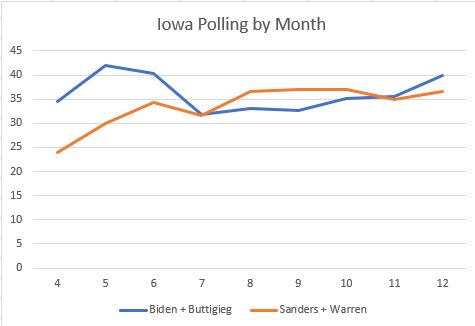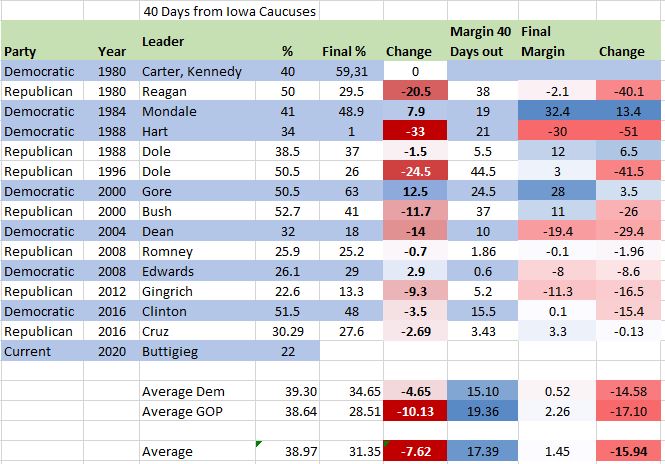Dan Guild: “Pete Buttigieg has the lead now, but his share of the vote is the lowest in Iowa caucus history for a leader.” -promoted by Laura Belin
We are now 40 days from the Iowa caucuses. I wrote a piece here entitled “Let the buyer REALLY beware” 45 days before the 2016 caucuses. That piece noted that front-runners rarely improve either the final percentage or their margin. This short article follows up on my analysis from 2015.
First, a quick look at the state of the Democratic race. A couple of things to note:
Joe Biden is the weakest national front runner in Iowa in history. No national leader has ever been under 20 percent in Iowa at this point. The closest parallel is probably Hilary Clinton in 2008, but her polling numbers were consistently over 20.
Pete Buttigieg has the lead now, but his share of the vote is the lowest in Iowa caucus history for a leader (though Newt Gingrich’s lead in the 2012 Republican race was close).
There are four candidates over 10 percent in polling. That has happened only once before in a Democratic primary (1988). In fact, one recent poll from Emerson showed five candidates over 10 percent.
This chart includes the most recent Iowa caucus polling.

One thing worth noting: when you combine the Warren and Sanders numbers, they have been stable since June. There is some evidence that the Biden+Buttigieg percentage is increasing, but that increase has been marginal. You might think of this graph as representing the two “lanes” in Iowa, though politics is never that simple.

That is the history. Some things to note:
The leader at this point has been under 30 percent three times. That leader has never won. The 2004 case is a good example of why: fire was pointed at Dean in the last 40 days and he declined (though not before the last 10 days). We began to see this play out in the most recent debate with multiple attacks on the Iowa leader, Buttigieg.
In December 1987, Gary Hart re-entered the presidential race and quickly took the lead in Iowa. Most people didn’t think the lead was real. His support was kind of a resting place for those who are undecided.Though the situation is different, I think this may be the case with Buttigieg. Polling indicates that up to 80 percent of Buttigieg’s supporters say they may change their mind. I suspect that much of Buttigieg’s support is made up of people who for one reason have problems with Biden and Sanders, but who have not settled on their final choice.
Only three times has the front runner’s margin increased since 1980. It hasn’t happened since 2000.
This race is different: the lead is small, and the leader is a newcomer and not well known.
The parallels to Howard Dean in 2004 are obvious, though so too in a way are the parallels to Barack Obama in 2008. Obama trailed only marginally in 2008.

I will return to this subject closer to February 3.




